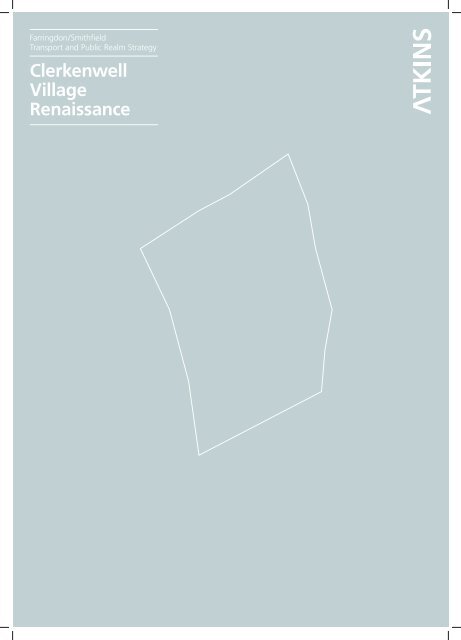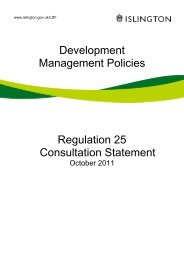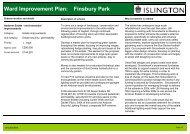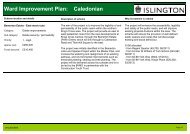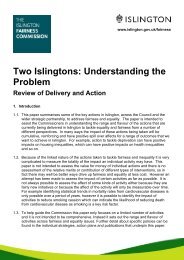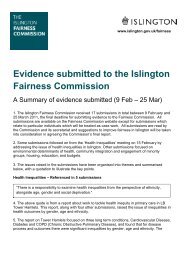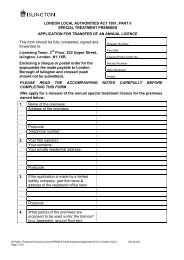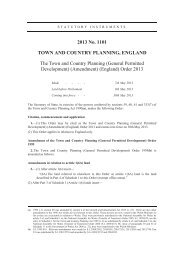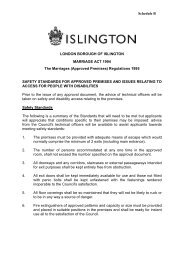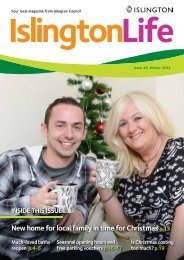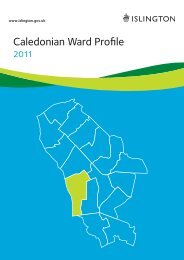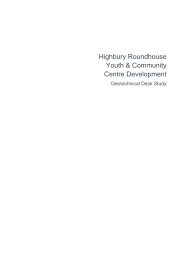Clerkenwell Village Renaissance Study - part 1 - Islington Council
Clerkenwell Village Renaissance Study - part 1 - Islington Council
Clerkenwell Village Renaissance Study - part 1 - Islington Council
You also want an ePaper? Increase the reach of your titles
YUMPU automatically turns print PDFs into web optimized ePapers that Google loves.
Farringdon/Smithfield<br />
Transport and Public Realm Strategy<br />
<strong>Clerkenwell</strong><br />
<strong>Village</strong><br />
<strong>Renaissance</strong><br />
<strong>Clerkenwell</strong> <strong>Village</strong> <strong>Renaissance</strong> Executive Summary
<strong>Clerkenwell</strong> <strong>Village</strong> <strong>Renaissance</strong> Executive Summary
<strong>Clerkenwell</strong> <strong>Village</strong> <strong>Renaissance</strong> Executive Summary
01<br />
02<br />
Executive Summary<br />
<strong>Clerkenwell</strong> <strong>Village</strong> <strong>Renaissance</strong> Executive Summary<br />
Introduction and History<br />
Introduction and History ..........................................4<br />
Street Lighting<br />
<strong>Study</strong> Area Plan .......................................................6<br />
History in Maps .......................................................8<br />
Historical Evolution ................................................ 13<br />
The Clerks Well: Monastic Era<br />
Sessions House<br />
Craftsmen<br />
Music<br />
Political History<br />
Dickens and Oliver Twist<br />
Photographic <strong>Study</strong>: Past and Present .................... 20<br />
Site context<br />
Health, Recreation and Leisure Destinations ........... 32<br />
Education Destinations .......................................... 32<br />
Pedestrian Activity ................................................. 33<br />
Weekday Rush Hour<br />
Weekday Lunch Hour<br />
Weekday Weekend Evening<br />
Entertainment ....................................................... 35<br />
Local Destinations ................................................. 35<br />
03<br />
04<br />
05<br />
Past, Present and Future Ideas<br />
What has been done already .................................40<br />
Conservation Designations .............................. 41<br />
Stakeholder Consultation Summary ................. 42<br />
Crossrail ..........................................................44<br />
Thameslink ......................................................44<br />
London Plan – Central Activities Zone<br />
‘Area of Intensification‘ .............................46<br />
Further Consultation: English Heritage .............46<br />
Millenium Proposals ........................................48<br />
Sustainable Transport Initiatives .......................48<br />
Public Realm Improvements .............................50<br />
City of London Public Realm Improvements ..... 52<br />
Planning Applications ...................................... 52<br />
Photographic survey<br />
Farringdon and <strong>Clerkenwell</strong> Roads .........................58<br />
Charterhouse Street ..............................................60<br />
St John Street ........................................................ 62<br />
<strong>Clerkenwell</strong> Green .................................................64<br />
St John’s Square ....................................................66<br />
Cowcross Street ....................................................68<br />
Turnmill Street ....................................................... 70<br />
Local Streets.......................................................... 72<br />
Pedestrian Routes and Small Streets ....................... 76<br />
Movement and Transport<br />
Transport Methodology .........................................84<br />
General Vehicle Peak Hour Counts<br />
Traffic Movement ..................................................86<br />
General Vehicle Movement as Existing<br />
General Vehicle Movement Proposed Improvements<br />
Pedestrian Movement ...........................................88<br />
Pedestrian Peak Hour Counts<br />
General Pedestrian Routes<br />
Cycle Movement ...................................................90<br />
Pedal Cycle Peak Hour Counts<br />
Cycle Routes<br />
Parking, Loading and Road Safety ......................... 92<br />
Accidents per mode<br />
Parking Survey (See Appendix D)<br />
Transport Issues and Recommendations .................94
<strong>Clerkenwell</strong> <strong>Village</strong> <strong>Renaissance</strong> Executive Summary<br />
Vision 06 07<br />
Key Objectives of the Vision ................................ 100<br />
Quick Wins ......................................................... 100<br />
Vision Plan .......................................................... 101<br />
St John’s Benjamin Street Park ............................. 102<br />
Street Trees ......................................................... 102<br />
Public Conveniences ............................................ 103<br />
Replacement of Kerbs ......................................... 104<br />
Feature Lighting and Maintenance ....................... 104<br />
Expanded Vision Plan Key .................................... 105<br />
New Plazas<br />
Shared Surfaces<br />
Parking<br />
Residential and Permit Holder Parking<br />
Loading Only Parking<br />
Motor Cycle Parking<br />
Pay and Display Parking<br />
Shared Vehicle Parking Spaces<br />
Footway Widening<br />
Footway Repaving<br />
Place Making Surface Treatments<br />
Secure Bicycle Parking<br />
New Active Use<br />
Multi-functional Space<br />
Purpose Built Kiosks<br />
Taxis Stand<br />
Raised Entry Treatments<br />
‘White’ Lighting<br />
New Lawns<br />
Best Practice Interventions ....................................116<br />
Future Possibilities ................................................118<br />
08<br />
09<br />
Action plan<br />
Comparative Cost Analysis .................................. 126<br />
Project Action Plan<br />
Cost Estimate Methodology<br />
P01 – St John Street ............................................ 128<br />
P02 – Benjamin Street<br />
P03 – Benjamin Street: North Footway<br />
P04 – St John’s Lane and Gate<br />
P05 – St John’s Square South<br />
P06 – St John’s Square North<br />
P07 – St John’s Lane<br />
P08 – Jerusalem Passage<br />
P09 – Passing Alley<br />
P10 – St John’s Passage<br />
P11 – Albion Place and Benjamin Street South Footway<br />
P12 – Britton Street<br />
P13 – Briset Street<br />
P14 – Faulkner’s Alley<br />
P15 – Charterhouse Street<br />
P16 – Cowcross Gate New Plaza<br />
P17 – Turnmill Street<br />
P18 – Intersection of Turnmill Street & <strong>Clerkenwell</strong> Road<br />
P19 – <strong>Clerkenwell</strong> Green South<br />
P20 – <strong>Clerkenwell</strong> Bridge and Farringdon Lane<br />
P21 – <strong>Clerkenwell</strong> Green North to Vine Street<br />
P22 – Cowcross Street Central<br />
P23 – Greenhill Rents<br />
P24 – Farringdon Station Forecourt<br />
P25 – Broad Yard<br />
P26 – Eagle Court<br />
Conclusions and Recommendations<br />
Key Recommendations ........................................ 160<br />
Other Recommendations ..................................... 160<br />
Major Traffic Management Improvements ........... 161<br />
Appendices<br />
Appendix A – Conservation Plan.......................... 166<br />
Listed Buildings<br />
Locally Listed Buildings<br />
Listed Streetscape Features<br />
Appendix B – Consultation Report ....................... 169<br />
Appendix C – Package Priority Schedule .............. 173<br />
Appendix D – Parking Survey and Accident Plan ...174<br />
Appendix E – Feature Lighting ............................. 177<br />
Acknowledgement .......................................... 178<br />
Associated Separate Documents<br />
Equality Impact Assessment<br />
Consultation Questionaire Response Spreadsheet
Executive Summary<br />
The proposals for the <strong>Study</strong> Area as detailed in the<br />
following chapters provide a clear and coherent<br />
vision for the streets of Smithfield, Farringdon and<br />
<strong>Clerkenwell</strong> as well as a phased action plan to achieve<br />
it. The result is a document that will support funding<br />
bids and ensure future public realm projects fit within<br />
the agreed ‘Vision’.<br />
The approach has been strategic and complements<br />
existing initiatives in the area including the Crossrail<br />
and Thameslink proposals approved by the<br />
government in October and July 2007 respectively.<br />
The production of this report was also developed with<br />
a clear understanding of similar policy and strategy<br />
developed to guide the continuing regeneration of the<br />
area by Terry Farrell and Partners for English Heritage:<br />
Smithfield Farringdon – Reinforcing Urban Identity<br />
& Character (February 2007).<br />
This report is the result of a six month multidisciplinary<br />
collaboration between Atkins and LB<br />
<strong>Islington</strong> officers.<br />
<strong>Clerkenwell</strong> and Smithfield are two of Central<br />
London’s most well loved and vibrant urban villages.<br />
The <strong>Study</strong> Area has a rich history dating from Roman<br />
times although remains of a prehistoric encampment<br />
found on <strong>Clerkenwell</strong> Green suggest that this <strong>part</strong> of<br />
London may have been inhabited for many thousands<br />
of years. (Akroyd, 2000)<br />
Consultation<br />
Key stakeholder consultation with representatives<br />
from London Underground, Transport for London,<br />
Network Rail, Crossrail, Thameslink, The Corporation<br />
of London, London Borough of Camden,<br />
The Public Carriage Office, Living Streets and the<br />
Ward <strong>Council</strong>lor was also undertaken.<br />
This project aims to address the needs of the<br />
residents, local workers and visitors. The primary<br />
issues of concern as established through the key<br />
stakeholder consultation are as follows:<br />
•<br />
•<br />
•<br />
•<br />
•<br />
•<br />
•<br />
•<br />
•<br />
Traffic volumes especially ‘rat runs’ through the area.<br />
The design of the highways which enable<br />
inconsiderate driver behaviour in place of<br />
pedestrian and cyclist priority.<br />
Insufficient safe crossings.<br />
Equitable access and the quality of the pavements.<br />
Street clutter and inconsistency of street furniture.<br />
Parking overprovision.<br />
Public convenience provision and anti-social behaviour.<br />
Wayfinding.<br />
Illegal street trading.<br />
All of the above listed major issues have been<br />
addressed in this document and a variety of methods<br />
of achieving the council’s aim to provide safe, secure,<br />
accessible, attractive and sustainable streets have<br />
been discussed. Atkins recognises that funding to<br />
enforce the removal of illegal trading is limited and<br />
has touched on physical strategies to address this in<br />
the public realm.<br />
Although none of the key stakeholders lived or<br />
worked in the area, Atkins lead project team member<br />
is a resident. It was brought to the attention of<br />
the consultation group that ‘Green Space’ was<br />
underprovided in the area and there was considerable<br />
pressure on the small amount of existing green space<br />
especially on sunny summer lunch times.<br />
Vehicle, Pedestrian and Cyclist Counts<br />
Conflicts between vehicles, pedestrians and cyclists<br />
were primarily located where high volumes of all<br />
modes were found to be using the same limited<br />
space through the peak counts undertaken as <strong>part</strong> of<br />
this study. In short the findings are:<br />
• Pinch point at the <strong>Clerkenwell</strong> Road rail bridge<br />
endangers the many cyclists using this route.<br />
• ‘Rat-running’ along Farringdon Lane and Turnmill<br />
and Cowcross Streets to Charterhouse Street<br />
endangers the high volumes of pedestrians that<br />
use these streets in all peak periods. This will be<br />
accentuated with a predicted 83% increase in<br />
pedestrian volumes once both Thameslink and<br />
Crossrail are in place.<br />
• Lack of sufficient safe crossing opportunities for<br />
<strong>Clerkenwell</strong> Road at St John’s Square endanger the<br />
many pedestrians that use St John’s Lane, Square<br />
and Jerusalem Passage as a north/south link.<br />
• Lack of a clear pedestrian route along the western<br />
edge of St John’s Square south forces pedestrians<br />
in the path of white vans and other vehicles that<br />
use this space for loading.<br />
• Insufficient footway width forces the many<br />
pedestrians that use Benjamin Street in all peaks<br />
onto the carriageway in the path of vehicles<br />
exiting onto Turnmill Street.<br />
• ‘Rat-running’ from St John Street through<br />
<strong>Clerkenwell</strong> Green to Farringdon Lane, especially<br />
by postal vehicles endangers the many pedestrians<br />
that use this area.<br />
• Vehicles exiting Cowcross Street (many of which<br />
have rat-run from Farringdon Lane) block south<br />
bound traffic onto St John Street.<br />
• Accessing the motor / cycle parking in the middle<br />
of St John Street is dangerous.<br />
• Cycle routes on St John Street are ill-defined and<br />
parked cars force cyclists into the carriageway.<br />
Details of the cycle, traffic and pedestrians counts can<br />
be found in Chapter Five of this report.
<strong>Clerkenwell</strong> Green<br />
Sketch model of potential<br />
improvement scheme. Issues<br />
and opportunities subject to<br />
further consultation.<br />
<strong>Clerkenwell</strong> <strong>Village</strong> <strong>Renaissance</strong> Executive Summary<br />
The Vision<br />
The Vision for <strong>Clerkenwell</strong>, Farringdon and Smithfield<br />
has evolved from LB <strong>Islington</strong>’s aim to provide safe,<br />
secure, accessible, attractive and sustainable streets. It<br />
has been developed with a clear understanding of the<br />
study areas vibrancy, potential and the major projects<br />
which will shape its future (Crossrail and Thameslink).<br />
The Vision has also been developed with a clear<br />
understanding of competing demands for <strong>Islington</strong>’s<br />
limited space and a balance has been sought to<br />
ensure the safe and efficient movement of people<br />
and goods. The Vision therefore gives priority to road<br />
users in the following order:<br />
•<br />
•<br />
•<br />
•<br />
•<br />
•<br />
•<br />
Pedestrians and people with mobility and sensory<br />
difficulties<br />
Cyclists<br />
Users of public transport<br />
Taxis and delivery vehicles<br />
Users of cleaner-fuel vehicles<br />
Users of motorcycles and scooters<br />
Other road users.<br />
It is important that any co-ordinated strategy / vision is<br />
designed to renew the public realm to last into the next<br />
century and also create new high quality public spaces<br />
that can host diverse activities and improve the setting<br />
of the historic townscape. In summary this has been<br />
delivered through the following key interventions:<br />
• Traffic direction reversal on Turnmill and<br />
Cowcross Streets. This will remove ‘cut-through’<br />
traffic that uses Farringdon Lane Turnmill Street,<br />
Cowcross Street and Charterhouse Street to<br />
access the Barbican and south Smithfield. This<br />
intervention will preclude conflicting movements<br />
of vehicles across <strong>Clerkenwell</strong> Road and will ensure<br />
that traffic entering the <strong>Study</strong> Area is accessing<br />
<strong>part</strong>icular destinations only.<br />
• St John Street new plaza and ordered public<br />
realm. Footway widening, parking and cycle lane<br />
re-organisation has enabled the creation of a<br />
new public and green space at the intersection of<br />
Peters Lane and St John’s Lane on St John Street.<br />
•<br />
•<br />
•<br />
•<br />
•<br />
•<br />
•<br />
West Cowcross Street / Farringdon Station<br />
forecourt / Benjamin Street limited access<br />
new plaza. Timed to coincide with Crossrail<br />
and Thameslink, closure of Cowcross Street from<br />
Turnmill Street to Farringdon Road (emergency<br />
vehicles excepted) will remove conflicts with<br />
pedestrians, the volumes of which are predicted to<br />
rise sharply. A shared surface between Cowcross<br />
and Turnmill Streets will double as traffic calming.<br />
Cowcross, St John and Charterhouse Streets<br />
new plaza and remedied traffic arrangement.<br />
Creating a standard T-junction along with the<br />
reversal of Cowcross Street will remove most<br />
vehicle / pedestrian conflicts and allow for the<br />
creation of a new urban plaza and a more rational<br />
pedestrian crossing point.<br />
Footway widening on Turnmill Street. Parking<br />
on the western footway has been removed<br />
in order to facilitate footway widening here<br />
where large volumes of pedestrians are currently<br />
forced onto the carriageway at peak periods.<br />
This is especially beneficial where the proposed<br />
Thameslink entry points are located. Some Pay<br />
and Display parking spaces on the eastern footway<br />
have been used to relocate Permit and Resident<br />
holder spaces from the western footway.<br />
Priory of St Johns’ Gate new plaza. Extending<br />
the influence and improving the setting of this<br />
important piece of townscape will renew focus on<br />
the area’s rich history and strengthen its identity.<br />
Extending this plaza to the intersection of St<br />
John’s Lane and Briset Street with a shared surface<br />
will double as traffic calming.<br />
<strong>Clerkenwell</strong> Bridge. Bicycle Lanes in both<br />
directions on <strong>Clerkenwell</strong> Road over rail Bridge.<br />
Following the bridge strengthening works it is<br />
possible to install cycle lanes in both directions at<br />
this pinch point that will enable safer queuing at<br />
the lights for cyclists.<br />
Vine Street. Improving the physical environment<br />
of the Vine Street Bridge and increasing green<br />
space by installing a new shallow profile lawn.<br />
Removing the existing parking provisions here<br />
will reduce this location’s likelihood of generating<br />
crime. Increasing much needed green space in the<br />
area and at the base of <strong>Clerkenwell</strong> Green will<br />
draw pedestrians over the railways and into the<br />
historic location. Additionally <strong>part</strong>s of the bridge<br />
could also be sett up for market stalls.<br />
<strong>Clerkenwell</strong> Green. Specific proposals are on<br />
hold subject to further consultation; however<br />
issues and opportunities are addressed in this<br />
report. In summary a new urban focus could be<br />
achieved by defining <strong>Clerkenwell</strong> Green with<br />
a single material treatment (new plaza) from<br />
Sekforde Street to the Vine Street Bridge. Shared<br />
surfaces could be used to calm traffic entering<br />
the residential areas to the north and ‘rat-running’<br />
could be removed and accidents avoided by
Cowcross Street –<br />
Farringdon Station<br />
Forecourt<br />
An enlarged place which<br />
is less cluttered to cater for<br />
the needs of convenient<br />
and attractive pedestrian<br />
movement.<br />
St John Street<br />
‘Hick’s Hall Place’<br />
Sketch view showing the<br />
proposed western footway<br />
widening of St John Street.<br />
Also shown is a potential<br />
new active use on the site of<br />
the former Hick Hall and<br />
later the Edwardian toilets.<br />
<strong>Clerkenwell</strong> <strong>Village</strong> <strong>Renaissance</strong> Executive Summary
KEY<br />
<strong>Clerkenwell</strong> Green proposals<br />
subject to further consultation<br />
See Action Plan for Issues<br />
and Opportunities<br />
L<br />
5M<br />
L L<br />
VISION PLAN<br />
New Plazas ........................................<br />
Footway Widening.............................<br />
Footway Repaving..............................<br />
Place Making Surface Treatments.......<br />
Cycle Lanes........................................<br />
Shared Surfaces<br />
All vehicle shared route ..................<br />
Emergency vehicle .........................<br />
Driveway access shared route .........<br />
Secure Bicycle Parking........................<br />
New Active Use..................................<br />
Multi Functional Space.......................<br />
Purpose Built Kiosks...........................<br />
Parking<br />
Pay & Display Parking .....................<br />
Shared Vehicle Parking Spaces........<br />
Motor Cycle Parking.......................<br />
Resident & Permit Holder Parking ...<br />
Loading Only Parking .....................<br />
Taxi Stand.......................................<br />
Raised Entry Treatments .....................<br />
‘White’ Lighting.................................<br />
New Lawns........................................<br />
L<br />
R R L<br />
4M<br />
T T T T T<br />
R<br />
R<br />
R<br />
4M<br />
R R<br />
R<br />
R<br />
R<br />
4M<br />
4M<br />
R<br />
R R R<br />
R<br />
4M L L<br />
L<br />
6M<br />
R R R R R<br />
14M<br />
4M R R R<br />
L L L<br />
L L<br />
Contra-flow cycle lane on<br />
Cowcross Street subject to<br />
feasibility.<br />
New Crossings ................................... Existing trees are not shown<br />
for clarity purposes<br />
L<br />
5M<br />
5M<br />
L<br />
L L<br />
R R R<br />
L<br />
2M<br />
L<br />
2M<br />
R R<br />
R<br />
R<br />
L<br />
L<br />
L<br />
R<br />
2M<br />
7M<br />
R<br />
R 7M<br />
L<br />
7M<br />
L L<br />
S 3M<br />
R R R<br />
L<br />
5M<br />
R<br />
7M<br />
P P P<br />
2M<br />
R R<br />
S
St John Street<br />
Artist’s impression of<br />
a new plaza created at the<br />
intersection of St John Street<br />
and St John’s Lane. New<br />
green space, cycle parking<br />
and public conveniences<br />
feature here.<br />
<strong>Clerkenwell</strong> <strong>Village</strong> <strong>Renaissance</strong> Executive Summary<br />
closing vehicle access to Farringdon Lane. New<br />
green space could be created (especially on the<br />
Vine Street Bridge) and public conveniences could<br />
be re-provided at ground level, paid for and<br />
managed by a new active use, (a café or small<br />
store which the area lacks) at the location of the<br />
existing underground Edwardian facilities.<br />
A full explanation of the Vision, including several<br />
other smaller yet just as important interventions<br />
(like traffic calming and footway resurfacing) can be<br />
found in Chapter Six.<br />
The main strategies employed to achieve the above<br />
mentioned Vision are as follows:<br />
Improve the Pedestrian Network<br />
•<br />
•<br />
•<br />
•<br />
•<br />
•<br />
•<br />
•<br />
•<br />
Ensure accessibility for all users.<br />
Widen pavements where possible.<br />
Provide pedestrian priority across minor streets.<br />
Identify and improve pedestrian walking links.<br />
Strengthen a legible pedestrian environment.<br />
Identify potential shared streets.<br />
Identify safe and useful places to rest.<br />
Create coherent pedestrian landscapes.<br />
Improve gateways and humanise streets.<br />
Reduce Through Traffic<br />
•<br />
•<br />
•<br />
•<br />
Improve traffic calming measures.<br />
Address ‘rat running’ accident hot spots.<br />
Emphasise entry points to the area.<br />
Reduce road space where possible.<br />
Improve Cycle Facilities<br />
• Redesign dedicated cycle lanes to make them<br />
clearer and safer.<br />
• Reduce the occurrence of illegal parking on cycle<br />
lanes through design.<br />
• Increase cycle parking provision where it is<br />
needed most.<br />
Rethink Parking<br />
•<br />
•<br />
•<br />
•<br />
•<br />
Introduce pavement build-outs and pocket parking.<br />
Reconsider the quantity of Pay and Display parking.<br />
Remove ‘walls’ of parking that inhibit pedestrian<br />
movement.<br />
Define parking areas and reduce the impact of<br />
Tarmac.<br />
Provide dedicated spaces for loading to reduce<br />
conflicts between white vans and pedestrians.<br />
Enhance Identity<br />
• Introduce a coherent palette of materials<br />
appropriate to the areas’ heritage.<br />
• Create a setting for future public art.<br />
• Celebrate local amenities.<br />
• Strengthen connections to green spaces that form<br />
<strong>part</strong> of the existing identity.<br />
Enable Activities<br />
• Improve connections between streets and green<br />
spaces and increase green space where possible.<br />
• Improve safety and perceptions of personal<br />
security by improving lighting where possible.<br />
• Create a high quality public realm that sets the<br />
scene for permanent, flexible and transient<br />
activities.<br />
• Balance the night time economy with other<br />
community uses.<br />
Improve the Visual Environment<br />
•<br />
•<br />
•<br />
•<br />
•<br />
Reduce street clutter.<br />
Install a low maintenance high quality public realm.<br />
Increase street tree planting and greenspace<br />
where possible and appropriate.<br />
Enable appropriate outdoor dining opportunities<br />
e.g. St John’s Street.<br />
Introduce a feature lighting strategy for key nodal<br />
locations and courts, alleys and paths in order<br />
to highlight alternate routes and points of activity<br />
and interest.
<strong>Clerkenwell</strong> <strong>Village</strong> <strong>Renaissance</strong> Executive Summary<br />
•<br />
Create a design code or hierarchy of sensitive<br />
treatments.<br />
Project Action Plans<br />
The Vision Plan for Smithfield, Farringdon and<br />
<strong>Clerkenwell</strong> has been broken into 26 project parcels.<br />
This component of the report aims to generate a<br />
reasoned estimate of cost for each project parcel<br />
that LB <strong>Islington</strong> can prioritise and procure funding<br />
for. Each project parcel action plan sets out a list of<br />
design treatments appropriate to the street hierarchy<br />
proposed in the ‘Vision’. The rates used to generate<br />
these cost estimates have been mostly based on LB<br />
<strong>Islington</strong>’s term contract. Additionally, an estimation<br />
of the cost of fees to completion has also been<br />
included. These figures have been based on 35% of<br />
the value of the estimated capital cost, as directed by<br />
LB <strong>Islington</strong>.<br />
The exact breakdown of quantities used and<br />
assumed, and provisional sums applied is documented<br />
in a spreadsheet supplied to LB <strong>Islington</strong>s’ officers but<br />
not included in this document as the rates used are<br />
commercially sensitive. Detailed parcel plans can be<br />
found in Chapter Seven and a project parcel priority<br />
schedule can found in Appendix C.<br />
Recommendations<br />
Full details of key recommendations and other<br />
recommendations for further investigation are made<br />
in Chapter Nine of this report. These are summarised<br />
below:<br />
Key Recommendations<br />
1. Improvements to the streets and pedestrian<br />
environment<br />
Specific project parcels have been drawn up and can<br />
be found in chapter 7 (Action Plan). The parcels order<br />
of priority has been determined in the priority matrix<br />
in Appendix C.<br />
2. Quick wins<br />
Aside from the 26 packages of work a number<br />
of ‘quick wins’ have been identified which can be<br />
completed as funding becomes available. These<br />
include:<br />
• Installing dropped kerbs at side streets, or<br />
appropriate locations and repaving areas of<br />
uneven paving and trip hazards to ensure universal<br />
accessibility.<br />
• A way finding study to identify locations for<br />
finger posts and monolith mapping should be<br />
commissioned. This should be looked at in relation<br />
to existing documented historic trails.<br />
• A street furniture audit to identify items for ‘decluttering’<br />
and items for retention and renovation.<br />
• Repainting and or renovation of existing historic<br />
street furniture.<br />
Other Recommendations<br />
1. Improved Lighting<br />
The use of ‘white light’ would increase the perceived<br />
sense of personal security and reduce anti social<br />
behaviour, especially in some of the smaller passages<br />
and alleys of the <strong>Study</strong> Area. As street lighting is<br />
replaced and maintained under a LB <strong>Islington</strong>’s 25 Year<br />
PFI contract more detailed investigation of the costs and<br />
implications of these proposals should be undertaken<br />
at feasibility stage.<br />
2. Sustainable Transport<br />
Increasing parking spaces for shared car schemes is<br />
proposed in the Vision however the financial and<br />
political implications of using existing Pay and Display<br />
parking (even when underused) to achieve this needs<br />
to be addressed at feasibility stage.<br />
3. Sustainable reuse of materials<br />
Many of the existing kerbs and paved surfaces are<br />
nearing the end of their life. Strategies to re-use these<br />
on-site have been identified in this report and should<br />
be further developed at feasibility stage.<br />
4. Resident and key stakeholder consultation<br />
on opportunities for <strong>Clerkenwell</strong> Green<br />
Consultation on issues and opportunities for<br />
<strong>Clerkenwell</strong> Green as detailed in this report should<br />
be undertaken with the local community of<br />
residents, businesses and other interest groups<br />
prior to improvement to this historic location being<br />
formalised.<br />
5. Public convenience provision<br />
Further investigation into the feasibility of private<br />
re-provision and management of public conveniences<br />
at <strong>Clerkenwell</strong> Green and St John Street tied to new<br />
active uses here should be carried out. Alternately<br />
the feasibility of providing retractable dual sex toilets<br />
/ urinals at key locations and the implications in terms<br />
of management and the availability of sufficient<br />
ground depth should also be addressed.
<strong>Clerkenwell</strong> <strong>Village</strong> <strong>Renaissance</strong> Executive Summary
Introduction<br />
01<br />
and History
Right: Aerial oblique
4<br />
<strong>Study</strong> Area<br />
Aerial oblique showing the<br />
study area, bounded by<br />
major routes and a network<br />
of smaller streets and alleys.<br />
Introduction and History<br />
The area of Farringdon/Smithfield lies within the<br />
London Borough of <strong>Islington</strong>, immediately to the north<br />
of the Corporation of London and east of the London<br />
Borough of Camden. It is an area with a rich cultural<br />
and social history. Its fabric has responded to change<br />
throughout history and today is seen as an area of<br />
development and intensification for the future.<br />
The aim of this report is to set out a ‘Vision’<br />
for streetscape improvements that complement<br />
the London Borough of <strong>Islington</strong>s’ policies on<br />
sustainability, parking and a safe pedestrian<br />
environment. The report also provides an action<br />
plan and programme that will not be compromised<br />
by future development works and can be delivered<br />
in phases as funding becomes available.<br />
The core proposals in this document were prepared<br />
following a key stakeholder consultation event on the<br />
18 th July 2008. Key Stakeholders were engaged through<br />
a site walkabout and attendees were invited to a<br />
workshop. A questionnaire was distributed and the<br />
information interpreted from these has been used as<br />
the basis for the ‘Vision’ and a order of priority of the<br />
works packages. (See Appendix C)<br />
The Farringdon/Smithfield area has a long history<br />
of settlement. Remains of a prehistoric encampment<br />
have been discovered on <strong>Clerkenwell</strong> Green and<br />
records show the area belonging to St Paul’s in the<br />
seventh century AD. It has evolved from a village<br />
lying just outside the City walls, with monastic<br />
orders growing crops, to a fashionable resort with<br />
tea gardens and theatres in the 17 th century. The<br />
Industrial Revolution brought breweries, distilleries<br />
and printers to the area which intensified with a fine<br />
grain development of numerous alleys, courts and<br />
yards many of which can still be found today.
Farringdon – Smithfield<br />
This axonometric shows<br />
variations in the scale and<br />
massing of development<br />
around the southern<br />
Smithfield Market <strong>part</strong> of<br />
the study area.<br />
<strong>Clerkenwell</strong> <strong>Village</strong> <strong>Renaissance</strong> 01 Introduction and History<br />
The Victorian era bought the Farringdon Metro<br />
Station and the completion of Smithfield Meat<br />
Market. Like much of London, Farringdon/Smithfield<br />
suffered from World War II bombing and slum<br />
clearance but much of the principal fabric remains<br />
and many of the streets, such as Cowcross, Turnmill<br />
and St John Streets have followed the same<br />
alignment for hundreds of years. Today the area is<br />
populated by loft-living young professionals, night<br />
clubs, restaurants and professional offices and<br />
businesses. Future projects affecting the area include<br />
the Thameslink and Crossrail proposals.<br />
Surveys have shown high levels of pedestrian activity<br />
in the area, in <strong>part</strong>icular relating to the many offices<br />
during the day and leisure activities at night.<br />
Streetscape opportunities, as detailed in this document<br />
concentrate on creating a sustainable pedestrian<br />
environment, focusing on equality of access, legibility<br />
and safety of the existing routes for all users. Also<br />
opportunities to re-address the lack of green, plaza<br />
and break out spaces have been identified.<br />
Street Lighting<br />
The lighting in the area is predominantly of high<br />
pressure sodium lamps (yellow light), which do<br />
not emit the same quality of light as the white light<br />
luminaries. Improved lighting would increase the<br />
perceived sense of personal security especially in<br />
some of the smaller passages and alleys. It would also<br />
decrease opportunities to commit crime as perceived<br />
by would be muggers, thieves and vandals.<br />
Street lighting is replaced and maintained under<br />
a LB <strong>Islington</strong>’s 25 Year PFI contract and a sum will<br />
need to be calculated over and above the supply<br />
of new luminaries to cover maintenance costs of<br />
increased white lighting.<br />
Source: 3-D London<br />
5
1 Farringdon Road<br />
2 Charterhouse Street<br />
3 St John Street<br />
4 <strong>Clerkenwell</strong> Road<br />
5 <strong>Clerkenwell</strong> Green<br />
6 Vine Street<br />
7 Aylesbury Street<br />
10<br />
6<br />
8 St John’s Square<br />
9 Albemarle Way<br />
10 Farringdon Lane<br />
11 Turnmill Street<br />
12 Cowcross Street<br />
13 Benjamin Street<br />
14 Britton Street<br />
1<br />
5<br />
21<br />
12<br />
15 St John’s Lane<br />
16 St John’s Place<br />
17 Briset Street<br />
18 Albion Place<br />
19 Eagle Court<br />
20 Jerusalem Passage<br />
21 Broad Yard<br />
11<br />
22<br />
14<br />
7<br />
4<br />
23<br />
24<br />
20<br />
16<br />
13<br />
22 Turk’s Head Yard<br />
23 Faulkner’s Alley<br />
24 St John’s Path<br />
25 Passing Alley<br />
26 Peter’s Lane<br />
27 White Horse Alley<br />
28 Greenhill’s Rents<br />
2<br />
8<br />
17<br />
18<br />
8<br />
27<br />
9<br />
19<br />
15<br />
28<br />
25<br />
Broad <strong>Study</strong> Area Boundary<br />
Streets of <strong>Study</strong> Area<br />
Pedestrian Routes <strong>Study</strong> Area<br />
26<br />
3
1906<br />
Junction of <strong>Clerkenwell</strong><br />
Road and Goswell Road<br />
showing the construction<br />
of tram tracks (removed in<br />
the 1950s) which in <strong>part</strong><br />
determine the wide radii of<br />
the current kerb alignments.<br />
2006<br />
Vision for the A1 Corridor.<br />
View showing a possible<br />
future for the intersection of<br />
Goswell Road and Old Street<br />
<strong>Study</strong> Area<br />
7<br />
Source: Atkins A1 Borough
8<br />
1550<br />
1560<br />
1570<br />
1580<br />
1590<br />
1600<br />
1610<br />
1620<br />
1630<br />
1640<br />
1650<br />
1660<br />
1670<br />
1680<br />
1690<br />
1700<br />
1710<br />
1720<br />
1730<br />
1740<br />
1750<br />
1760<br />
1770<br />
1780<br />
1790<br />
1800<br />
1810<br />
1820<br />
1830<br />
1840<br />
1850<br />
1860<br />
1870<br />
1880<br />
1890<br />
1900<br />
1910<br />
1920<br />
1930<br />
1940<br />
1950<br />
1960<br />
1970<br />
1980<br />
1990<br />
2000<br />
2010<br />
History in Maps<br />
1553–1559: Civitas Londinum<br />
Known as the ‘Agas’ view, Ralph Agas produced<br />
this artistic survey depicting London in the 1550s.<br />
Superimposing the study area, shows the River Fleet<br />
running along the western boundary (now Farringdon<br />
Road). The river’s substantial flow of water, meant<br />
a large number of wells were built along its banks,<br />
and some on springs, including Bagnigge Well in<br />
<strong>Clerkenwell</strong>. <strong>Clerkenwell</strong> Road, Turnmill Street,<br />
Cowcross Street and St Johns Street alignments are<br />
all recognisable and divide the area into a variety<br />
of uses and associated plot sizes. <strong>Clerkenwell</strong> is<br />
a distinct village right outside the London City Walls,<br />
with Smithfield Market neighbouring its south east<br />
corner used as London’s main livestock market.<br />
Source: A-Z Elizabethan London
1550<br />
1560<br />
1570<br />
1580<br />
1590<br />
1600<br />
1610<br />
1620<br />
1630<br />
1640<br />
1650<br />
1660<br />
1670<br />
1680<br />
1690<br />
1700<br />
1710<br />
1720<br />
1730<br />
1740<br />
1750<br />
1760<br />
1770<br />
1780<br />
1790<br />
1800<br />
1810<br />
1820<br />
1830<br />
1840<br />
1850<br />
1860<br />
1870<br />
1880<br />
1890<br />
1900<br />
1910<br />
1920<br />
1930<br />
1940<br />
1950<br />
1960<br />
1970<br />
1980<br />
1990<br />
2000<br />
2010<br />
<strong>Clerkenwell</strong> <strong>Village</strong> <strong>Renaissance</strong> 01 Introduction and History<br />
1676:<br />
In the 17 th century <strong>Clerkenwell</strong> became a fashionable<br />
place of residence, it had a reputation as a resort<br />
where Londoners could disport themselves at spas,<br />
tea gardens and theatres. The congregation of<br />
settlements for living and trade, are reflected in the<br />
density and configuration. The finer-grain which<br />
develops along the major routes, such as <strong>Clerkenwell</strong><br />
Green and St Johns Court (now St John’s Square) are<br />
the principal public spaces. St Johns Gate is one of<br />
the few tangible remains from <strong>Clerkenwell</strong>’s monastic<br />
past, by Prior Thomas Docwra as the south entrance<br />
to the inner precinct of the Priory of the Knights of<br />
St John – the Knights Hospitallers.<br />
1740s: Georgian London<br />
Rocque’s map of 1746 shows the study area bounded<br />
by St Johns Street to the east and Saffron Hill (<strong>part</strong><br />
of the existing Farringdon Road) to the west, with<br />
<strong>Clerkenwell</strong> Green on the north and West Smithfield<br />
on the south. It is truncated by Turnmill Street which<br />
bends to the east and connects to Cowcross Street.<br />
This area is close to the medieval layout of the<br />
historic city fringe. The Georgian layout underlines<br />
the orientation of the existing development blocks.<br />
9<br />
Source: A-Z Georgian London
10 <strong>Clerkenwell</strong> <strong>Village</strong> <strong>Renaissance</strong> 01 Introduction and History<br />
1550<br />
1560<br />
1570<br />
1580<br />
1590<br />
1600<br />
1610<br />
1620<br />
1630<br />
1640<br />
1650<br />
1660<br />
1670<br />
1680<br />
1690<br />
1700<br />
1710<br />
1720<br />
1730<br />
1740<br />
1750<br />
1760<br />
1770<br />
1780<br />
1790<br />
1800<br />
1810<br />
1820<br />
1830<br />
1840<br />
1850<br />
1860<br />
1870<br />
1880<br />
1890<br />
1900<br />
1910<br />
1920<br />
1930<br />
1940<br />
1950<br />
1960<br />
1970<br />
1980<br />
1990<br />
2000<br />
2010<br />
Source: A-Z Regency London<br />
1800s: Regency London<br />
The map shown above is the survey undertaken by<br />
William Faden in 1813. London at the time was the<br />
largest city in the world. <strong>Clerkenwell</strong> had been greatly<br />
changed by the Industrial Revolution. It had become<br />
a centre for breweries, distilleries and the printing<br />
industry. The expansion from individual houses to<br />
an increased number of courtyard arrangement,<br />
is especially noticeable along Turnmill and Cowcross<br />
Streets. St Johns Court had been transformed to the<br />
present St Johns Square. The centre of the village<br />
at <strong>Clerkenwell</strong> Green was surrounded by a mix of<br />
housing, offices and public houses.<br />
1850–1900: Victorian London<br />
Bacon’s map of 1888 shows the characteristics<br />
of London at the height of the industrial revolution.<br />
Farringdon Metro Station was opened in January<br />
1863 and along with the completion of Smithfield<br />
Meat Market in 1888, created a defined edge to the<br />
southern boundary of the study area. Charterhouse<br />
Street was also formed and the majority of buildings<br />
previously located on the SW corner were cleared<br />
for railway lines and associated uses.<br />
Source: A-Z Victorian London
1550<br />
1560<br />
1570<br />
1580<br />
1590<br />
1600<br />
1610<br />
1620<br />
1630<br />
1640<br />
1650<br />
1660<br />
1670<br />
1680<br />
1690<br />
1700<br />
1710<br />
1720<br />
1730<br />
1740<br />
1750<br />
1760<br />
1770<br />
1780<br />
1790<br />
1800<br />
1810<br />
1820<br />
1830<br />
1840<br />
1850<br />
1860<br />
1870<br />
1880<br />
1890<br />
1900<br />
1910<br />
1920<br />
1930<br />
1940<br />
1950<br />
1960<br />
1970<br />
1980<br />
1990<br />
2000<br />
2010<br />
<strong>Clerkenwell</strong> <strong>Village</strong> <strong>Renaissance</strong> 01 Introduction and History<br />
1900–1950<br />
This OS map (1916) shows the study area street<br />
pattern before the fragmentation caused by the<br />
World War II bombing and the slum clearance in the<br />
early to mid 20 th century. The area cleared would<br />
have predominantly been residential terraced streets<br />
constructed during Georgian and Victorian eras.<br />
1950–2007<br />
A general revival and gentrification process began<br />
in the 1990s, and the area is now known for<br />
accommodating businesses and professional services<br />
as an overspill area from the nearby City of London<br />
and the West End. It also seen as an area for loftliving,<br />
nightclubs, restaurants and art galleries which<br />
are mixed in with existing social housing.<br />
11<br />
Source: Google Earth
<strong>Clerkenwell</strong> <strong>Village</strong> <strong>Renaissance</strong> 01 Introduction and History
1830<br />
(Left) St John Street looking<br />
towards St Paul’s Cathedral<br />
prior to the construction<br />
of the Smithfield Market<br />
Buildings on the site<br />
illustrated as the market<br />
place. The restored Market<br />
Buildings are a handsome<br />
backdrop but reduce<br />
legibility and permeability to<br />
the adjacent areas.<br />
Historical Evolution<br />
The <strong>Study</strong> Area includes historic districts whose<br />
character has continually changed in response to<br />
London’s evolution. These districts include <strong>Clerkenwell</strong>,<br />
West Smithfield and Farringdon and their associated<br />
routes like St John Street, Farringdon Road, <strong>Clerkenwell</strong><br />
Road, Charterhouse Street and Cowcross Street.<br />
<strong>Clerkenwell</strong> and its neighbouring areas are<br />
a fascinating reminder of the ancient origins and<br />
workings of London. It characterises London’s<br />
emergence from Roman and Medieval eras into a<br />
world city. Slightly elevated, and beyond the old City<br />
walls and the historic market of the Smithfield area,<br />
the hamlet of <strong>Clerkenwell</strong> grew. The original assets<br />
1642<br />
A view of St John Street<br />
(then St John’s) looking<br />
south towards St Paul’s<br />
Cathedral, shows an artist’s<br />
impression of the Civil War<br />
defences aligned east-west<br />
and crossing to the west of<br />
the Turnmill Brook. These<br />
works are identified on a<br />
1739 map as a battery and<br />
breastwork. The wide northsouth<br />
route was clearly an<br />
important approach which<br />
had a fort to the north at the<br />
New River Pond.<br />
1819<br />
St John’s Street Turnpike.<br />
This historic feature, which<br />
may have been located in<br />
line with the Priory Gate<br />
near today’s Passing Alley<br />
could be the inspiration<br />
for improved highway<br />
and landscape design at<br />
appropriate locations.<br />
of fertile meadowland, natural springs and the Fleet<br />
River, initially encouraged wealthy residents (the Earls<br />
of Northampton had a mansion halfway up St John<br />
Street), as well as Almshouses and schools. In King<br />
Charles II time the great houses were abandoned<br />
to merchants and craftsmen, <strong>part</strong>icularly during the<br />
1665 Plague followed by the Great Fire of London in<br />
1666. Commerce and industry overused and polluted<br />
watercourses like the Fleet River (or River of Wells,<br />
known locally in <strong>Clerkenwell</strong> as Turnmill Brook). The<br />
overcrowded slums made the area notorious inspiring<br />
Dickens and Hogarth to graphically depict them in<br />
words and pictures.<br />
13
14 <strong>Clerkenwell</strong> <strong>Village</strong> <strong>Renaissance</strong> 01 Introduction and History<br />
Today<br />
Views of St John’s Gate is<br />
obscured by trees.<br />
1896<br />
St John’s Gate built in 1504<br />
by Sir Thomas Docwra.<br />
Here Dr. Johnson had an<br />
office and Garrick made his<br />
theatrical debut in London,<br />
playing the leading comic<br />
<strong>part</strong> in Fielding’s ‘Mock<br />
Doctor’. The setting has<br />
changed relatively little<br />
although now substantial<br />
trees and the once elegant<br />
paving is now cluttered by<br />
bollards and modern lighting<br />
equipment.<br />
1560<br />
View of <strong>Clerkenwell</strong> showing<br />
the Church of St James, the<br />
Clerk’s Well and Spring and<br />
a house belonging to the<br />
Knight’s Templar.<br />
The Clerk’s Well : Monastic Era<br />
Early monastic foundations in the area included the<br />
convent of St Mary’ which drew its water from the<br />
Clerk’s Well (Fons Clericorum) and the Priory of<br />
St John of Jerusalem, founded in the 12 th Century<br />
by a Norman Knight Jorden de Briset. The main<br />
St John’s Gate to the original Priory built in 1504 still<br />
survives, housing the Order of St John Museum and<br />
shows the status and importance of an area. After<br />
the dissolution of the monasteries by Henry VIII the<br />
Gatehouse was used in many ways, reflecting the<br />
changing fortunes of the area. These uses included :<br />
•<br />
•<br />
•<br />
17 th Century : The office of Elizabeth I’s ‘Master<br />
of the Revels’.<br />
18 th Century : A coffee house, run by the father<br />
of William Hogarth the engraver, and in 1731–81<br />
it was the printing works of the Gentleman’s<br />
Magazine (Contributors : Johnson, Garrick<br />
and Goldsmith among others), later a parish<br />
watch house.<br />
19 th century : A public house known as the<br />
Old Jerusalem. In 1874, when Queen Victoria<br />
established the British Royal Order of Chivalry for<br />
the Most Venerable Order of the Hospital of<br />
St John of Jerusalem it was acquired by the Order<br />
and in 1877, from here the St John’s Ambulance<br />
Brigade was launched.<br />
The Convent of St Mary stood roughly where the<br />
present St James Church stands today.<br />
Source: Round London
1779–82<br />
The Second Sessions House<br />
at <strong>Clerkenwell</strong> showing<br />
details of paved surfaces,<br />
lighting, wooden post and<br />
rails and cast iron bollards.<br />
Today<br />
(Right) The <strong>Clerkenwell</strong><br />
Sessions House Today.<br />
1755<br />
Updated version of Stow’s<br />
Survey, showing the location<br />
of Hick’s Hall in the middle<br />
of St John Street which<br />
supports the Victorian view<br />
of its design and form.<br />
<strong>Clerkenwell</strong> <strong>Village</strong> <strong>Renaissance</strong> 01 Introduction and History<br />
Sessions House<br />
In 1612 the area’s importance to justice in the City<br />
had been reflected in the building of the first Sessions<br />
House (Hick’s Hall) at the foot of St John Street. This<br />
relocated a function that had previously operated in<br />
Smithfield taverns. Famous cases included the trials in<br />
1660 of: “…twenty nine regicides, murtherers of his<br />
most sacred Majesty, King Charles I…”.<br />
The second (Old Middlesex) Sessions House was built<br />
in 1779–82 at <strong>Clerkenwell</strong> Green functioning until<br />
1921. Within this a fireplace from the original Hick’s<br />
Hall and portrait of it’s founder, Sir Baptist Hicks were<br />
installed, though since removed.<br />
1750<br />
15<br />
Victorian engraving<br />
representing the probable<br />
appearance of Hick’s Hall,<br />
the first Sessions House<br />
in St John Street. This island<br />
site can still be identified<br />
in the widened street and is<br />
an important local feature<br />
which could be reinterpreted<br />
in the landscape design<br />
solution and any local<br />
information panels.
16 <strong>Clerkenwell</strong> <strong>Village</strong> <strong>Renaissance</strong> 01 Introduction and History<br />
1836<br />
Charterhouse Street looking<br />
east showing Horace Jones’<br />
1862–68 Smithfield’s 3.5<br />
acre London Central Meat<br />
Market buildings. The<br />
traditional public realm<br />
treatment is an ordered<br />
arrangement of footways in<br />
York stone and granite kerbs<br />
together with historic low<br />
level street lights at regular<br />
intervals.<br />
Source: Round London
1890<br />
Booth’s (Gin) Distillery at<br />
83–85 Turnmill Street is<br />
a fine example of the ornate<br />
industrial building stock.<br />
The view highlights the<br />
generally uncluttered street<br />
appearance.<br />
Today<br />
83–85 Turnmill Street, is<br />
a site enclosing <strong>part</strong>s of the<br />
public realm including Turks<br />
Head Yard. Its open access<br />
drive ways and car parks are<br />
considered crime generators.<br />
<strong>Clerkenwell</strong> <strong>Village</strong> <strong>Renaissance</strong> 01 Introduction and History<br />
Craftsmen<br />
Those discouraged by the restrictive practices of<br />
the old Guilds, settled and worked outside the<br />
City. Among these were refugees like the French<br />
Huguenots in the 17 th century which resulted in the<br />
<strong>Clerkenwell</strong> area becoming an urbanised centre for<br />
clock and watch making, jewellery, printing and gin<br />
distillers (including Booth’s, Gordon’s and Nicholson’s)<br />
and brewers including Whitbread’s.<br />
Music<br />
George Frederic Handel played with a local man<br />
Thomas Britton, self educated in music who was<br />
one of the most famous of <strong>Clerkenwell</strong>s’ street<br />
vendors. Known as the ‘musical coal man’, he lived in<br />
one room above a stable at Jerusalem Passage. He<br />
drew the attention of some of the greatest musicians<br />
of the day and Brittons’ music club met at his<br />
humble room for 40 years where Handel played the<br />
harpsichord, Bannister or Medler first violin, while<br />
Britton played on the Viol da gamba.<br />
17
1946<br />
(Left) <strong>Clerkenwell</strong> Green.<br />
This image shows how the<br />
Green has been dominated<br />
by vehicles for many<br />
generations. Before the car,<br />
coaches and horses would<br />
have used the space. Also<br />
notable is the electrical<br />
catenary supply and the<br />
Marx Memorial Library which<br />
still exists today.<br />
<strong>Clerkenwell</strong> <strong>Village</strong> <strong>Renaissance</strong> 01 Introduction and History<br />
Political History<br />
Sited outside of the City of London the area became<br />
a home for outcasts and those who wished to be<br />
beyond the law from early times. It also became<br />
a home for religious groups, including Jesuits, Papists<br />
and Quakers.<br />
<strong>Clerkenwell</strong> Gaol built in 1775, was known as<br />
‘a jail for hereticks’ due to the number of radicals<br />
imprisoned there.<br />
The radical history of <strong>Clerkenwell</strong> continued in the<br />
19 th century with the Tolpuddle Martyrs greeted on the<br />
Green on their return from Botany Bay and Chartists<br />
meetings in Lunt’s Coffee House at 34 <strong>Clerkenwell</strong><br />
Green. Nine separate trade Unions met regularly in the<br />
area in various pubs and coffee houses.<br />
The London Patriotic Club (1872–1892) was set up<br />
as : “…a place for political lectures and discussions<br />
independent of coerced tavern keepers and licensing<br />
magistrates, …”. The lecture rooms occupied the<br />
site of premises originally built in 1737 as the Welsh<br />
Charity School for Children of Poor Welsh Families<br />
in London which had been subdivided into shops<br />
and coffee-rooms. In 1892, William Morris backed<br />
the Twentieth Century Press, social democratic<br />
publishers, which was visited by famous Socialists<br />
such as Kropotkin and Eleanor Marx. In 1902–3 Lenin<br />
published 17 issues of Iskra (The Spark) from here.<br />
In 1933 the Marx Memorial Library (an independent<br />
subscription library) occupied the site.<br />
Dickens and Oliver Twist<br />
Scenes set in <strong>Clerkenwell</strong> are to be found in a<br />
number of Dicken’s novels including Oliver Twist,<br />
Barnaby Rudge, Great Expectations, Bleak House,<br />
A Tale of Two Cities and Our Mutual Friend.<br />
<strong>Clerkenwell</strong> Green was the setting for the<br />
pickpocketting of Mr Brownlow by the Artful Dodger,<br />
Charley Bates and Oliver. The narrow court from<br />
which the boys emerged to rob Mr Brownlow is<br />
generally assumed to be Pear Tree Court which is off<br />
<strong>Clerkenwell</strong> Close.<br />
Dickens also describes Smithfield Market in Oliver<br />
Twist as: “…the crowding, pushing, driving, beating,<br />
whooping and yelling, the hideous and discordant din<br />
that resounded from every corner of the market…<br />
rendered it a stunning and bewildering scene which<br />
quite confounded the senses…”.<br />
In the 1860’s Dickens was active in the campaign<br />
to reform the London meat markets – notably<br />
Smithfields.<br />
19<br />
Source: Dickens in <strong>Islington</strong>
20<br />
Photographic <strong>Study</strong>:<br />
Past and Present<br />
20 th Century<br />
1907. This image shows how the Vine Street Bridge was<br />
an important gateway to <strong>Clerkenwell</strong> Green. It also shows<br />
the variety of street furniture including early electric arc<br />
lights, Windsor lanterns and William IV style ribbed bollards<br />
and ‘coaching stone’ protections.<br />
1906. Jerusalem Passage, derelict slums and shops rendered<br />
the area unsafe and undesirable. This view shows how the<br />
Passage was paved in traditional flagstones.<br />
21 st Century<br />
Today. <strong>Clerkenwell</strong> Green with the Vine Street Bridge seen<br />
in the foreground from <strong>Clerkenwell</strong> Road. This image shows<br />
just how cluttered the public realm has become. In the<br />
foreground there is a redundant dedicated and separated<br />
cycle lane which may be able to be brought into use once<br />
the current bridge strengthening works are complete. A lift<br />
and escalator repairs workshop for London Underground<br />
obscures the view and setting of the historic townscape.<br />
Today. Jerusalem Passage is a popular destination for<br />
after work drinks and dinner. It also forms an important <strong>part</strong><br />
of the main pedestrian north / south route through the area.<br />
The flagstone paving has been replaced with patched asphalt<br />
and an uneven granite sett central channel.
<strong>Clerkenwell</strong> <strong>Village</strong> <strong>Renaissance</strong> 01 Introduction and History<br />
20 th Century<br />
1920. St John Street looking north from St John’s Churchyard.<br />
This image shows the shear volume of traffic generated by<br />
the Smithfield Markets and the businesses of central London.<br />
St John Street has always been a major north/south route.<br />
The traditional paving of carriageway in setts, footway<br />
in flagstones edged in granite kerbs can be seen in detail.<br />
1902. St John Street looking west at the newly completed<br />
Mallory Buildings for the working class. St John’s Court was<br />
publicly accessible but gated at this time.<br />
21 st Century<br />
Today. The parade of shop fronts still exists today. A hair<br />
salon now occupies the shops and the York stone pavements<br />
have been replaced with mastic.<br />
Today. Mallory Buildings on St John Street. Semi public /<br />
private space is often targetted by would be criminals. The<br />
gate as shown, only stops vehicles entering and does not<br />
provide the psychological barrier of the original gates shown<br />
in the adjoining image.<br />
21
22 <strong>Clerkenwell</strong> <strong>Village</strong> <strong>Renaissance</strong> 01 Introduction and History<br />
20 th Century<br />
1922. Detail of proposed kiosk at Farringdon Street Station<br />
(Farringdon), on Charles Street now Cowcross Street.<br />
1922. This plan shows how circulation at the station<br />
forecourt has always been an issue. Kiosks need to be<br />
located away from pedestrian desire lines.<br />
21 st Century<br />
Today. Newsagent Kiosk outside Farringdon Station.<br />
This setup relies on the Station awning to provide weather<br />
protection and because of this the kiosk has not moved<br />
away from the station entrance since the forecourt has<br />
been widened.<br />
Today. Illegal fruit seller outside Farringdon Station. Prior to<br />
the recent widening of the forecourt this seller was located<br />
on the footway, forcing pedestrians onto the road.
<strong>Clerkenwell</strong> <strong>Village</strong> <strong>Renaissance</strong> 01 Introduction and History<br />
20 th Century<br />
1946. Britton Street at St John’s Path. After the Second World<br />
War much of the area was in decline. The Jerusalem Tavern,<br />
a long standing institution in the area is closed in this view.<br />
1946. Footways here have always been narrow. These<br />
properties on the north side of Benjamin Street have been<br />
demolished and replaced by St John’s Benjamin Street Park.<br />
21 st Century<br />
Today. Britton Street at St John’s Path today. This street<br />
drinking is typical of any public house in the area. No longer<br />
in decline the public realm design does not reflect or support<br />
how it is currently used.<br />
Today. The St John’s Benjamin Street Park is a densely<br />
planted green space, enclosed by railings with few clear sight<br />
lines in or out.<br />
23
24 <strong>Clerkenwell</strong> <strong>Village</strong> <strong>Renaissance</strong> 01 Introduction and History<br />
20 th Century<br />
1973. Eagle Court. This street has changed little in recent<br />
years. Primarily used as a service yard, the multiple rear entries<br />
alienate the pedestrian, rendering it undesirable as a route.<br />
1978. St John Street at Charterhouse Street. Although<br />
recent public realm changes here have improved the physical<br />
environment for pedestrians, the space is still dominated by<br />
vehicles and tarmac as it was in 1978. The difference is that<br />
hand delivery using trolleys was widely practiced, reducing<br />
the amount of delivery vehicles that needed to permeate<br />
deep into the site. Future delivery arrangements may be less<br />
detrimental to the pedestrian environment if modern trolleys<br />
and <strong>part</strong> hand delivery can be practically re-introduced.<br />
21 st Century<br />
Today. Eagle Court. This image taken from the St John’s<br />
Lane end of Eagle Court highlights the implications<br />
of development. Precedents set, like the original Victorian<br />
terrace over the street in the 1973 image adjacent have<br />
been duplicated upon redevelopment. This treatment<br />
‘semi privatises’ the street making it less used and therefore<br />
less safe.
<strong>Clerkenwell</strong> <strong>Village</strong> <strong>Renaissance</strong> 01 Introduction and History<br />
20 th Century<br />
1969. St John Street. Little has changed in the last 40 years in St John Street with an over provision of carriageway and space for<br />
parking. Narrow footways cut across by driveways with kerb up-stands and uneven surfaces are characteristic of the townscape.<br />
21 st Century<br />
Today. St John Street. The quality of the public realm is still poor in St John Street today. Layers of traffic related street clutter<br />
reduce legibility for pedestrians. Car parking is over provided and located over the top of designated cycle lanes. Street life<br />
has also been reduced with the introduction of some commercial buildings with inactive ground floor frontages (central right).<br />
25
26 <strong>Clerkenwell</strong> <strong>Village</strong> <strong>Renaissance</strong> 01 Introduction and History<br />
20 th Century<br />
1946. St John Square north. St John’s Square shown here<br />
resembles the Square today. Recent improvements have<br />
revealed the original granite paving. Dropped kerbs on the<br />
pedestrian desire line to Jerusalem Passage did not feature<br />
during this period and unfortunately have also been omitted<br />
from the recent public realm works.<br />
1983. St John Square north. The boom in car use had<br />
a detrimental effect on the Square. The original granite<br />
paving was covered in tarmac and parking and engineering<br />
businesses dominated its use.<br />
21 st Century<br />
Today. St John’s Square north. Recent public realm<br />
improvements make St John’s Square north a popular<br />
destination for workers in search of lunch time sun. Single<br />
yellow kerb side lines make the location desirable for short<br />
term parked cars, which often conflict with pedestrian<br />
movement northwards to Jerusalem Passage.<br />
Today. St John’s Square north see from the south.<br />
The tarmac has been removed to reveal the original granite<br />
paving, formal parking has been abolished yet St John’s<br />
Square remains dominated by cars due to its separation from<br />
the southern section by <strong>Clerkenwell</strong> Road. Poor pedestrian<br />
crossing facilities render the two spaces as separate entities.
<strong>Clerkenwell</strong> <strong>Village</strong> <strong>Renaissance</strong> 01 Introduction and History<br />
20 th Century<br />
1983. <strong>Clerkenwell</strong> Green. This image shows the dominance<br />
of car parking in <strong>Clerkenwell</strong> Green.<br />
19 th Century<br />
1897. This plan represents <strong>part</strong> of a planning application for<br />
changes to buildings around St John’s Church. The plan also<br />
shows the existence of Jerusalem Court which was demolished<br />
in the 20 th Century when the Churchyard was created.<br />
21 st Century<br />
Today. Although there are more places for Londoners to<br />
‘break-out’ in the Green today the space is still dominated by<br />
cars. Postal vehicles speed westwards along Aylesbury Street<br />
and through the Green at the end of shifts at around 4:30pm<br />
on their way back to the Mount Pleasant Sorting Office.<br />
21 st Century<br />
Today. St John’s Church cloister garden is sited where<br />
Jerusalem Court once existed. Privatisation of public space<br />
has been seen as a key method of removing crime generators<br />
in the 20 th century.<br />
27
Site Context<br />
02
<strong>Clerkenwell</strong> <strong>Village</strong> <strong>Renaissance</strong> 02 Site Context<br />
Right: Detail of Smithfield Poultry Market Facade
<strong>Clerkenwell</strong> <strong>Village</strong> <strong>Renaissance</strong> 02 Site Context
32<br />
Health, Recreation and Leisure Destinations<br />
EXMOUTH MARKET<br />
M.U.G.A YOUTH CENTRE<br />
VIE HEALTH CLUB<br />
JUNO LUCINA LADIES<br />
HEALTH CLUB<br />
GOOD VIBES<br />
FITNESS CLUB<br />
LA FITNESS CLUB<br />
FITNESS FIRST<br />
FITNESS FIRST<br />
Education Destinations<br />
THE BRIDGE SCHOOL<br />
CENTRAL SAINT MARTINS<br />
SCHOOL<br />
CHRISTOPHES HATTON PRIMARY<br />
SCHOOL<br />
ST ALBAN’S<br />
HOLBORN<br />
SCHOOL<br />
GRESHAM COLLEGE<br />
WILLIAMS COLLEGE<br />
<strong>Clerkenwell</strong> <strong>Village</strong> <strong>Renaissance</strong> 02 Site Context<br />
KINGS CROSS ROAD<br />
KINGS CROSS ROAD<br />
PENTONVILLE ROAD<br />
CLERKENWELL ROAD<br />
PENTONVILLE ROAD<br />
CLERKENWELL ROAD<br />
ROSEBERY AVE<br />
Virgin<br />
Gym<br />
Sadler’s<br />
Wells<br />
Theater<br />
FARRINGDON ROAD<br />
ROSEBERY AVE<br />
FARRINGDON ROAD<br />
ST JOHN STREET<br />
ANGEL<br />
FARRINGDON<br />
ANGEL<br />
FARRINGDON<br />
GOSWELL ROAD<br />
ST JOHN STREET<br />
GOSWELL ROAD<br />
BARBICAN<br />
CITY ROAD<br />
CITY ROAD<br />
BARBICAN<br />
OLD STREET<br />
OLD STREET<br />
CITY ROAD<br />
CITY ROAD<br />
OLD STREET<br />
OLD STREET<br />
LIVERPOOL STREET<br />
TRAIN STATION<br />
HOXTON SQ<br />
OLD STREET<br />
GREAT EASTERN ST<br />
LIVERPOOL STREET<br />
TRAIN STATION<br />
HOXTON SQ<br />
OLD STREET<br />
GREAT EASTERN ST<br />
KIINGSLAND STREET<br />
KIINGSLAND STREET<br />
Park<br />
Square<br />
HACKNEY ROAD<br />
CITY OF LONDON<br />
MIGRANE CLINIC<br />
BARBICAN YMCA<br />
VIRGIN ACTIVE<br />
Fitness Clubs<br />
LA FITNESS<br />
ST BARTHOLOMEWS<br />
HOSPITAL<br />
HACKNEY ROAD<br />
College<br />
Schools<br />
MEDICAL COLLEGE OF<br />
SAINT BARTHOLEMEWS<br />
THE CHARTERHOUSE<br />
SQUARTE SCHOOL<br />
CITY OF LONDON SCHOOL<br />
FOR GIRLS
Pedestrian Activity<br />
Weekday Rush Hour (am & pm).<br />
Major streets on pedestrian desire lines to and<br />
from work are the busiest during the weekday<br />
peak times of 8am–10am and 5pm–7pm. From<br />
these streets pedestrians filter into, and out of<br />
the business areas within and beyond the site.<br />
Benjamin Street and <strong>Clerkenwell</strong> Green are of<br />
note as main conduits beyond the major routes<br />
of Cowcross and Turnmill Streets and <strong>Clerkenwell</strong><br />
and Farringdon Roads.<br />
High Intensity<br />
Medium Intensity<br />
Low Intensity<br />
<strong>Clerkenwell</strong> <strong>Village</strong> <strong>Renaissance</strong> 02 Site Context<br />
Weekday Lunch Hour (noon).<br />
Weekday lunch sees people moving everywhere.<br />
Deliveries are made, meetings are attended and<br />
lunch is being sought. This is the area at its’ most<br />
dynamic and certain ‘hotspots’ are clear, including<br />
the cafe’s and restaurants of Cowcross Street,<br />
Farringdon Station and any small plaza (including<br />
White Horse Alley), patch of sun or green space<br />
for respite (Benjamin Street).<br />
33<br />
Weekday & Weekend (evening). <strong>Clerkenwell</strong><br />
is the home of two of London’s largest nightclubs,<br />
Turnmills and Fabric. The nightlife is centred on the<br />
north side of Smithfield Market, revellers gathering<br />
alongside delivery teams from across Europe at<br />
the meat market on nights throughout the week.<br />
Several pre-club bars such as Smith’s of Smithfield,<br />
Meet, The Castle and Bear Bar have flourished in<br />
the area.
<strong>Clerkenwell</strong> <strong>Village</strong> <strong>Renaissance</strong> 02 Site Context
CCTV coverage<br />
(Left) Generally visitors feel<br />
safe at night, <strong>part</strong>icularly<br />
in active streets. Good CCTV<br />
coverage is an essential<br />
component of public realm<br />
management strategy.<br />
<strong>Clerkenwell</strong> <strong>Village</strong> <strong>Renaissance</strong> 02 Site Context<br />
Entertainment<br />
FARRINGDON ROAD<br />
CLERKENWELL ROAD<br />
FARRINGDON<br />
ST JOHN STREET<br />
Local Destinations<br />
The level of activity in the <strong>Study</strong> Area changes<br />
distinctly between weekday/daytime and evenings/<br />
weekend. During the week the streets are dominated<br />
by office workers moving between the main<br />
access points of public transport, to the numerous<br />
professional and design offices located across the<br />
area. In the evenings and weekends the area is much<br />
quieter and the main focus of activities is around<br />
the night clubs and numerous bars and restaurants.<br />
The area is well served by public transport with<br />
bus routes on <strong>Clerkenwell</strong> Road (routes 55 and 243)<br />
and Farringdon Road (route 63). Farringdon Station<br />
is on the Metropolitan, Circle and Hammersmith<br />
and City Lines as well as Thameslink rail services.<br />
Good public transport provision encourages visitors<br />
to access the area on foot. There is limited access<br />
for mobility impaired visitors however, due to poor<br />
provision of drop kerbs and narrow footways.<br />
All areas of open space are well used during week<br />
day lunchtimes indicating a high demand for office<br />
workers to congregate during lunch breaks.<br />
BARBICAN<br />
OLD STREET<br />
Pubs, clubs and bars<br />
Licensed Restaurants<br />
The area has two main historic spaces, St John’s<br />
Square and <strong>Clerkenwell</strong> Green. <strong>Clerkenwell</strong> Green<br />
is currently dominated by an inefficient road network<br />
and car parking.<br />
The hierarchy of the road network includes busy<br />
roads (Farringdon Road A201, <strong>Clerkenwell</strong> Road<br />
A501) and minor side streets, down to a fine grain<br />
of narrow alleys, yards and rents. These alleys are<br />
characteristic of the area and they are well used, but<br />
in some cases are gloomy or unwelcoming. This can<br />
be attributed to poor lighting, modern buildings with<br />
no street level presence such as the old Booths’ Gin<br />
site or a blurring of public private space.<br />
35<br />
There are few facilities for families, the nearest school<br />
is just outside the <strong>Study</strong> Area in Corporation Row and<br />
there are no children’s play areas.
<strong>Clerkenwell</strong> <strong>Village</strong> <strong>Renaissance</strong> 02 Site Context
<strong>Clerkenwell</strong> <strong>Village</strong> <strong>Renaissance</strong> 03 Past, Present and Future Ideas<br />
Past, Present<br />
03<br />
and Future Ideas
<strong>Clerkenwell</strong> <strong>Village</strong> <strong>Renaissance</strong> 03 Past, Present and Future Ideas<br />
Right: Farringdon Station


